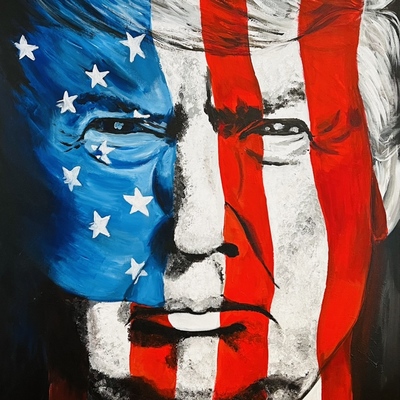
America Added Just 73,000 Jobs in July as Manufacturing Slump and Tariff Pressures Drag Down Hiring
The Tariff Reckoning: How Trade Policy Fractured America's Labor Recovery
WASHINGTON — Across America's manufacturing belt, a familiar pattern has emerged: factories that once hummed with three-shift operations now stand partially empty, their parking lots dotted with fewer cars each month. The economic reality behind these silent assembly lines crystallized in Friday's devastating employment report, which revealed the United States added merely 73,000 jobs against expectations of 100,000, while unemployment climbed to 4.2 percent—its highest level in over two years.
Behind these stark numbers lies a deeper story of policy-induced economic fracture. Manufacturing employment has plummeted to five-year lows, with factories shedding 11,000 positions in July alone as escalating trade tensions and tariff-driven cost pressures continue strangling business confidence across industrial America.

When Data Becomes Devastation
The Bureau of Labor Statistics data released Friday delivered a sobering assessment: the vaunted American job machine is sputtering. Manufacturing employment has collapsed to five-year lows, shedding 11,000 positions in July alone as trade policy uncertainty continues strangling business confidence.
Yet the headline figure understates the crisis. Massive downward revisions—258,000 jobs erased from May and June estimates—reveal a labor market already in free fall. The three-month hiring average has plummeted to just 35,000 monthly positions, the weakest sustained period since the pandemic's immediate aftermath.
"These revisions expose how dramatically we've misread the economic trajectory," observed Guy Berger, senior economist at the Burning Glass Institute. "The stability we thought existed was largely statistical illusion."
The manufacturing sector bears the deepest scars. The Institute for Supply Management reported its fifth consecutive month of contraction, with the employment index crashing to 43.4—territory not seen since July 2020's economic nadir. Factory managers across the industrial Midwest describe a perfect storm: elevated input costs from tariffs, evaporating export demand, and consumer retrenchment among younger demographics particularly sensitive to price increases.
The Policy Trap
Art Hogan, Chief Market Strategist at B. Riley Wealth, characterized July's employment collapse as "unambiguously reflecting the trade and tariff impact on economic growth." The administration's expansive tariff regime has created what economists term a dual economic drag—simultaneously inflating business costs while suppressing consumer demand.
Manufacturing companies report inventory liquidation as uncertain trade relationships force fundamental supply chain reassessments. S&P Global's Chris Williamson noted that factories experienced their first deterioration since December, with businesses growing "increasingly pessimistic about the year ahead, citing weakening customer demand and inflationary pressures from tariffs."
This policy-induced stagflation presents Federal Reserve officials with an unprecedented challenge. While Governors Christopher Waller and Michelle Bowman have signaled openness to interest rate reductions based on labor market softening, Chair Jerome Powell maintains that employment conditions remain "solid," emphasizing persistent inflation risks—particularly from tariff pass-through effects.
Fed Governor Raphael Bostic's assessment proved most candid: "Revisions in employment data are more noteworthy than the headline numbers," he acknowledged, while noting that "inflation risks have increased" even as job growth stalls.
Market Reckoning and Investor Implications
Financial markets absorbed the employment shock with characteristic volatility. The 10-year Treasury yield plunged 11.9 basis points to 4.241 percent, its steepest single-day decline since April, while gold futures surged 1.5 percent as investors sought refuge from dollar weakness.
The yield curve's dramatic steepening—with two-year rates falling faster than longer-term bonds—signals growing recession probability pricing among institutional investors. Fed funds futures now embed an 81 percent probability of September rate cuts, compared to 38 percent before Friday's release.
For astute investors, the data suggests a fundamental regime shift requiring tactical repositioning. The manufacturing sector's persistent weakness amid tariff-induced cost pressures argues for defensive positioning in cyclical equities, while quality growth companies with pricing power may prove more resilient.
Fixed income markets appear poised for continued curve steepening as growth concerns outweigh inflation fears in the near term. However, the tariff-driven supply shock complicates traditional recession playbooks—investors may find themselves navigating stagflationary crosscurrents that reward neither pure growth nor value strategies.
Credit markets remain surprisingly sanguine, with investment-grade spreads near cycle lows despite deteriorating fundamentals. This complacency suggests significant repricing risk should employment weakness broaden beyond manufacturing into services sectors that have sustained recent hiring growth.
Generational Economic Divergence
Perhaps most concerning for sustained recovery prospects is emerging evidence of generational spending retrenchment. Companies including Procter & Gamble and Chipotle report heightened price sensitivity among younger consumers, who are systematically reducing discretionary expenditures as tariff-inflated costs erode purchasing power.
This demographic shift carries profound implications for economic momentum. Unlike previous cycles where broad-based consumer resilience cushioned sectoral weakness, current growth increasingly depends on wealthy households while younger cohorts—traditionally crucial for expanding consumption—retreat from market participation.
Regional Federal Reserve surveys confirm this pattern: consumer confidence remains bifurcated, with high-income segments maintaining optimism while middle and lower-income groups express growing pessimism about near-term economic prospects.
Navigating the Policy Error Window
The confluence of weakening employment data, persistent inflation pressure, and internal Federal Reserve disagreement creates what strategists term a "policy error window"—conditions where monetary authorities face contradictory signals that increase miscalibration risks.
Historical precedent suggests such periods favor assets that benefit from policy uncertainty: gold, Treasury inflation-protected securities, and multinational corporations with geographic earnings diversification. Conversely, domestic cyclical sectors and regional banks face headwinds until policy clarity emerges.
Investment professionals should monitor several critical indicators in coming months: continued payroll revisions that could reveal deeper weakness, Federal Reserve communication that might signal more aggressive easing, and any tariff policy modifications that could alleviate manufacturing pressure.
The labor market's trajectory will likely determine whether America's economic slowdown remains manageable or deteriorates into broader recession. Friday's data suggests policymakers have entered a narrow corridor where recovery requires delicate balancing between trade policy recalibration and monetary accommodation.
Investment Thesis
| Category | Key Data/Insight | Market Implications |
|---|---|---|
| Labor Market | July payrolls +73k, downward revisions -258k; Unemployment 4.2% (2-year high) | Weak momentum signals recession risk; Fed funds futures now price 81% chance of Sep cut |
| Market Reaction | 2-yr yield ↓19bp (3.75%), 10-yr ↓15bp (4.24%); 2s-10s curve steepest since 2022 | Late-cycle steepening (similar to 2000/2007), not bullish |
| Macro Drivers | Tariffs hit manufacturing (ISM Mfg PMI 48.0) & discretionary spending | Stagflation risk: growth slows, inflation persists; Fed behind the curve |
| Credit Market | IG OAS 0.78% (cycle tights), HY spreads <350bp | Complacency—no risk premium for profit slowdown/default risk |
| Rates Strategy | 2s-10s steepener, TIPS breakevens <2.3%, profit-taking on ultra-long duration | Front-end driven by cuts, long end capped by growth fears |
| Equities Strategy | Underweight cyclicals, overweight tech/AI/defensive sectors (HC, utilities) | Tariff resilience in growth/defensive sectors |
| FX & Commodities | Short USD vs. CHF/JPY; gold buy dips (~$3,300); fade copper rallies | Policy error risk supports gold; copper weak on global PMIs |
| Scenarios (12M) | 25% Soft-Landing, 40% Grinding Stagflation, 35% Hard Downturn (baseline) | Stagflation = reluctant Fed easing, flat equities, wider credit spreads |
| Key Risks | Tariff escalation, Fed miscommunication, credit accidents, geopolitical wildcards | Market underpricing tail risks (e.g., Taiwan elections) |
| Monitoring Dashboard | Claims/JOLTS, GDPNow <1%, 2s-10s curve, IG OAS >100bp, breakevens >2.6% | Signals for recession confirmation or trade adjustments |
Final Takeaway: Barbell approach (long convexity/optionality) favored—fade soft-landing consensus, own steepeners/quality, and prepare for Fed policy shifts.
Table: Key Economic Metrics from the July 2025 U.S. Jobs Report
| Metric | Value |
|---|---|
| Nonfarm Payroll Jobs Added (July) | 73,000 |
| Expected Payroll Jobs | 100,000–115,000 |
| Unemployment Rate (July) | 4.2% |
| Unemployment Rate (June) | 4.1% |
| Downward Revisions (May + June) | 258,000 |
| May Jobs (Revised) | 19,000 |
| June Jobs (Revised) | 14,000 |
| 3-month Average Jobs (now) | 35,000 |
| 3-month Average Jobs (before) | 150,000 |
| Required Monthly Jobs to Stabilize Unemployment | 100,000–150,000 |
| Previous Requirement | 150,000–200,000 |
| Average Hourly Earnings (YoY) | 3.9% |
| Current Inflation Range | 2.6–2.8% |
| People Left Workforce (July) | ≈40,000 |
| Labor Force Participation YoY Change | -0.5% |
| Federal Government Jobs Lost (July) | 12,000 |
| Federal Government Jobs Lost (YTD) | 84,000 |
| Manufacturing Jobs Lost (July) | 11,000 |
| Factory Employment Level | Lowest in 5 Years |
| ISM Manufacturing PMI (July) | 48.0 |
| ISM Manufacturing PMI (June) | 49.0 |
| ISM Employment Index (July) | 43.4 |
| ISM Employment Index (June) | 45.0 |
| ISM Output Index (July) | 51.4 |
| ISM Output Index (June) | 50.3 |
| ISM New Orders (July) | 47.1 |
| ISM New Orders (June) | 46.4 |
| S&P Global US Manufacturing PMI | 49.8 (Lowest of 2025) |
| 10-year Treasury Yield (Post-report) | 4.24% |
| 2-year Treasury Yield (Post-report) | 3.75% |
| Gold Price Change (Post-report) | +1.5% |
| Dollar Index Change | More than -1% |
| GDP Growth (H1 2025) | 1.2% |
| GDP Growth Forecast (2025) | 1.5% |
| Expected Recession Odds (Futures) | 81% chance of Sept rate cut |
| 2s-10s Treasury Curve | +50 bps |
| Credit Spreads (IG OAS) | 0.78% (Cycle Tights) |
| Payrolls Base Case Scenario Rebound | >125,000 |
| Soft-Landing Probability (12m) | 25% |
| Stagflation Probability (12m) | 40% |
| Hard-Downturn Probability (12m) | 35% |
| Tariff Shock Impact (per 5 ppt) | +0.2pp to Core PCE, -0.1pp GDP |
NOT INVESTMENT ADVICE